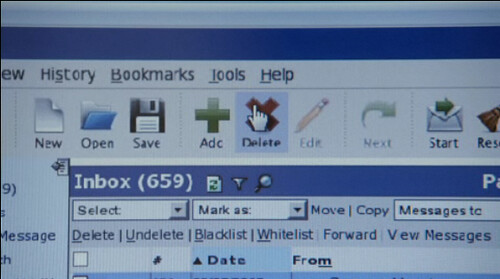March 2009 Archives
CBC/Radio-Canada announced some 800 job cuts this morning. Of those, 335 affected French services. Of those, they said 9 of them would affect Radio-Canada.ca, perhaps the largest French-language media website in the country. And one of those nine jobs turned out to be my position. =(
If you are looking to hire an IT specialist, with experience and a special interest in developing new means of communicating information, then here's my CV:
https://docs.google.com/Doc?id=dfn5mmm7_116g6cprdd6
I've done a few interesting things while I was there and learned a few technical things (rich Javascript apps, GIS) and a few more intangible things (working under pressure, working with real professionals). Great deal of stuff that I still want to do.
While I'm preparing to live on sprouted beans, ground pork and rice for the next few weeks, I'm also going to give my self-made projects a few more days of work before launching. I've really become obsessed with maps and other renderings of statistical data into something graphically appealing. The technical side is absolutely fascinating - the editorial one is even more so. Anyways, it's just talk for now. Stay tuned, then!
C'était le souper de fête à Doris, mais au bistro où on était, ils avaient une grosse tévé qui montrait la game de Canadien contre le Maple Leafs de Toronto. J'ai donc passé la soirée à hurler ma déception pendant que les Kulemin, Grabovski et Ponikarovsky s'amusaient aux dépends du bleu-blanc-rouge. Score final: 5-2.
Comme disait le Maxim Lapierre après la partie lors de la séance de torture devant la presse, la casquette bien basse, "sac', st..., e' va être dure à digérer celle-là".
Mais comment la digérer alors en tant que fan? Ben, on pourrait commencer par écrire sur son blogue. Certains préfèrent appeler sur les lignes ouvertes, ou bien se défouler sur les forums de discussion.
Vous pouvez aussi poursuivre en écoutant les échos de vestiaire, qui prennent de plus en plus des allures de scènes de funérailles. Josh Gorges, vers la fin du vidéo, essayait tant bien que mal de rationaliser, en se détachant du contexte, comme s'il était devenu un ancien joueur qui parle des mauvaises séquences de son équipe d'autrefois. Réjean Tremblay, chroniqueur au quotidien La Presse, nous rassurait lui aussi hier matin en relativisant les choses.
Franchement, j'ai beau m'imaginer dans ma tête qu'après celle-ci, les choses iront mieux. Comment je fais? J'essaie de penser positif, du genre, oh, les joueurs ont passé un beau samedi après-midi avec leur famille et ils auront le coeur à l'ouvrage. On en gagne une facile contre Toronto, pis c'est parti pour la gloire (scénario à l'eau depuis la fin de la première période ce soir). Pour mardi qui vient, je m'imagine que Sergei Kostitsyn apportera l'étincelle qu'il avait apporté en 2007-08.
Autrement, tu peux aussi écouter le point de presse de Gainey où il dit qu'il convoquera les joueurs qui ont mal joué samedi (pour leur dire quoi? qu'ils ont mal joué et qu'ils feraient mieux de ne pas recommencer??). Tu peux aussi aller checker du côté de Guillaume Latendresse dans l'émission d'après-match, au cours duquel il s'est permis de tourner ça avec le sourire avec les Michel Bergeron et Dave Morissette qui voulaient entre Gui dire ce qu'il pense _vraiment_, à la tévé. Même quand ça va mal, vaut mieux essayer d'en rire.
Tu peux aussi aller te défouler sur Facebook. J'ai posté la nouvelle sur Sergei Kostitsyn qui revenait à Montréal après son sevrage exil à Hamilton à faire de l'autobus avec le club-école de Canadien. Je l'ai postée avec bien entendu un petit commentaire sarcastique. Ça fait du bien.
Enfin, on peut aussi se dire que notre équipe est mieux que celle qui nous a battu et qui ratera les séries probablement pour une cinquième saison de suite. Pire encore, ta blonde pourrait te laisser, ta mère pourrait mourir, et tu pourrais perdre ta job (ça risque d'arriver, à cause des coupures à annoncer ce mercredi). Bref, y'a des choses pires que ça dans la vie.
Je pourrais aussi aller en Chine, là où la photo ci-dessus a été prise. J'ai alors manqué la presque déconfiture contre le Bruins de Boston, et comment le Flyers n'a finalement fait qu'une bouchée (ou cinq) de Canadien grâce au bourreau dénommé Umberger. Là-bas, personne n'avait rien à cirer de Canadien.
(PS: Dans la catégorie « Comment rationaliser la défaite », ne manquez pas ce texte du Sportnographe intitulé Serge K : "Je suis essentiel à la pérestroïka de Canadien".)
Ou encore, la caricature à Chapleau résume bien la situation:
This is a talk by Tim Berners-Lee. The project in my previous entry is merely an example of what Berners-Lee is advocating for.
(I'm going to release my complete method a little later.)
I've started putting some time again this weekend on the project that I was talking about last week.
To tell the truth, I had previously made this particular project work. In vague terms (I'll be less vague when I get something solid down), I was taking some huge sets of data from one particular national agency and making it meaningful on a geographic support, namely Google Earth. I did it, but it was terribly inefficient (what about loading thousands of points on the same map?) and unreadable (what if those points were all focused in urban areas?).
The next step was to use a less custom approach, with a web framework named Django, and its GIS libraries bundled into what's called GeoDjango. This framework can possibly use flat files as backend, but to store geographical data, the best choice is PostGreSQL and its extension PostGIS that adds the ability to store geographical data, as well as make operations of the kind of "select these points within a certain perimeter".
This is the neat part that I didn't have in my original project with a plain MySQL database backend. MySQL also has spatial extensions but does not support nearly as many spatial lookup types as PostGIS.
Now that I have my data in a database, I'm looking forward to play with the presentation part. It'll also be interesting to work on making this a compelling user experience.
I confess - I'm watching a gal series. However, I am staying true to myself, and pointing out that the main character of Being Erica probably uses Linux! The mail client in this screenshot of last week's episode Everything She Wants, the 9th of the season, she is using Horde on Firefox for her mail, on what looks like a Linux system with a really really old "Crux" theme.
I told myself that I would just write about what I'm doing in order to keep notes. So, this is basically just to keep track and for later to look back.
I'm working on a particular mashup for Google Earth. I actually had a version on a computer at work in December, but it was generated using a PHP program with a MySQL program. Besides having something that worked, my objective was also to make something that worked _efficiently_. Therefore, I've been trying to learn about new tools to do it more efficiently.
I first looked into web servers. Apache's HTTP Server is the default server everyone uses (if not IIS, guh). However, already with my last project, I had been experimenting with Lighttpd, one of those next-gen super-light web servers. nginx is the other that people use and is gaining ground as the fourth most popular web server according to Netcraft this month. Since I started with lighttpd, I decided to keep using it.
Then, I tried looking for a new language to use besides PHP, just because. I don't know if it's being tired of the same language one uses all the time or perhaps the reputation that other languages have. So this language would be Python, one language which I worked with in university during the course of one semester but didn't touch since then. The more you program, the easier you find picking up a new language is.
Then, I was looking for a Web framework, which greatly helps when developing web-based apps, which is what I want my application to be. So, I went for Django, which is today one of the leading Web frameworks for Python out there. Because geographical information is such an important component of today's world of mobile phones equipped with GPSes, then naturally there are geographical extensions written for Django which are part of GeoDJango.
From there, it's pretty exciting. I still need to see how I can store my geographically mashed data and how I can make retrieval efficient in Google Earth or any other platform supported by GeoDjango.
Everything is run from my laptop computer, because it's the best machine around over which I have entire control. Now, I should learn tricks about "getting work done" since that is definitely the most important hurdle right now...
L'autre jour, notre PDG Hubert T Lacroix a fait une apparition à l'émission matinale sur la Première Chaîne.





